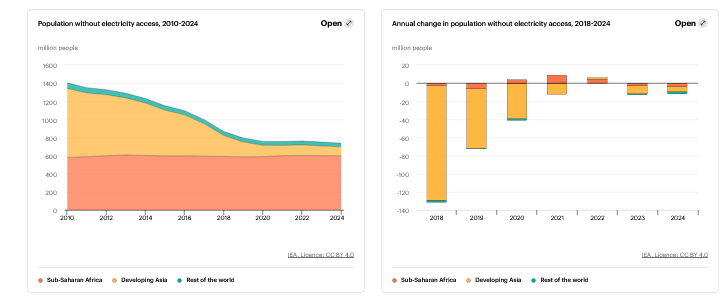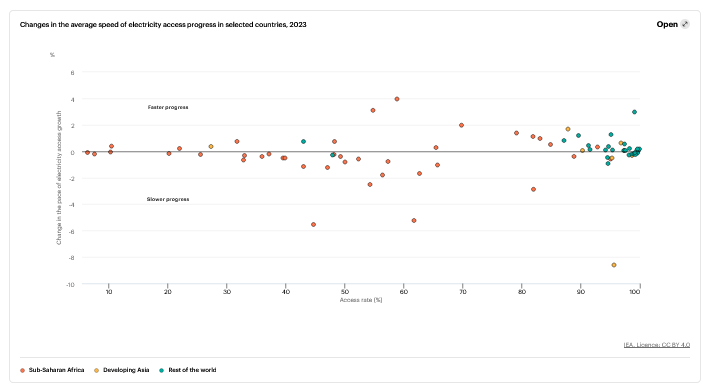The IEA's latest data show the number of people without access to electricity declined by more than 10 million from over 760 million in 2022 to below 750 million in 2023. This follows a period of stagnation and setbacks in extending electricity access, where population growth exceeded new connections in many countries. The IEA was the first to report that the number of people globally without access to electricity increased for the first time in decades in 2022 using data from new grid and off-grid connections a finding that was confirmed earlier this year by household surveys. Data for the first months of 2024 suggest that improvements are set to continue this year, as the number of people without access to electricity is expected to decline by a similar amount as in 2023.

Global improvements remain well below pre-2020 levels. Between 2015 and 2019, the population without access decreased each year by 80 million on average. This slowdown is largely due to countries such as India and Indonesia having achieved universal access in the same period. Still, in around 80% of the countries without universal access today it is still slower than in the late 2010s. Current improvement rates are far below what is necessary to reach the SDG7.1 target of universal electricity access by 2030, which requires the population without access to decrease on average ten times faster than today.

Most of developing Asia and Latin America get closer to universal electricity access, but major gaps persist in sub-Saharan Africa, where 80% of people without access live
Countries in developing Asia have made significant strides in expanding electricity access, with more than half a billion people gaining access in the past decade. India and Indonesia both reached universal access between 2021 and 2022, and Bangladesh hit the milestone in 2023. More than 70% of countries in the region have achieved access rates above 90%. As these countries approach universal access, progress has slowed as efforts to connect the last mile populations have proven more challenging. As of 2023, some 107 million people still lack access to electricity in the region, mostly in Pakistan, Myanmar, and Dem. People's Rep. of Korea.
Similarly, in Latin America, where most countries excluding Haiti have already achieved high levels of electrification, reaching the most remote and indigenous populations is proving more challenging than expected, but progress resumed again in 2023 after stagnating since the pandemic.
The most severe gap persists in sub-Saharan Africa, where 80% of the global population without electricity access live. After three years of backsliding, progress resumed in 2023, driven by an acceleration in grid connections, continued growth in solar-home systems deployment, and, to a lesser extent, new mini grids development. In 2023, 600 million sub-Saharan Africans1 still lacked access to electricity, a number higher than in 2019. Even with continued progress in 2024 as suggested by preliminary reporting, the number of people without access to electricity in the region will still be slightly higher than in 2019 by the end of this year.









